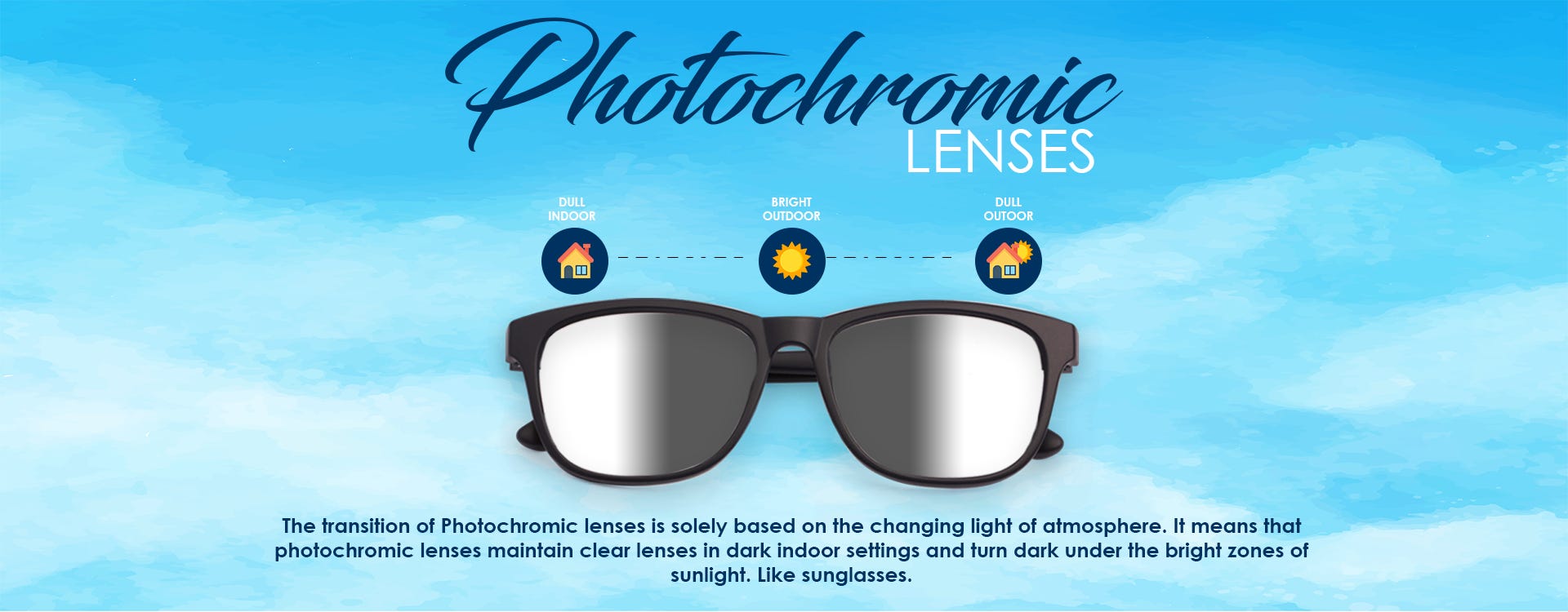Blog
The Benefits of Photochromic Lenses: Indoor and Outdoor Use
In the ever-evolving world of eyewear, photochromic lenses have emerged as a popular choice for those seeking both comfort and convenience. These innovative lenses automatically adjust their tint based on the surrounding light conditions, providing a seamless transition from indoor to outdoor environments. This article will explore the numerous benefits of photochromic lenses, their functionality, and how they can enhance your vision and lifestyle.
What Are Photochromic Lenses?
Photochromic lenses, also known as transition lenses, are optical lenses that darken when exposed to ultraviolet (UV) light and return to their clear state indoors or in low-light conditions. This technology was first introduced in the 1960s and has since evolved significantly, incorporating advanced materials and coatings to improve performance and comfort.
How Do They Work?
The technology behind photochromic lenses involves special molecules embedded in the lens material. When exposed to UV light, these molecules undergo a chemical reaction, causing the lenses to darken. When the UV light source is removed, the lenses return to their original clear state. This process happens quickly, typically within seconds to minutes, depending on the lens quality and the intensity of the light.
Benefits of Photochromic Lenses
1. UV Protection
One of the primary benefits of photochromic lenses is their ability to block harmful UV rays. Prolonged exposure to UV light can lead to various eye issues, including cataracts, macular degeneration, and photokeratitis. Photochromic lenses provide an effective barrier against these harmful rays, ensuring that your eyes are protected both indoors and outdoors.
2. Convenience and Versatility
Photochromic lenses eliminate the need to switch between prescription glasses and sunglasses. This convenience is especially beneficial for those who frequently transition between indoor and outdoor environments, such as:
- Commuters: If you walk or bike to work, you can enjoy clear vision without the hassle of carrying multiple pairs of glasses.
- Outdoor Enthusiasts: For hikers, runners, and cyclists, photochromic lenses provide the flexibility to adapt to changing light conditions seamlessly.
3. Enhanced Visual Comfort
The ability of photochromic lenses to adjust to varying light conditions enhances visual comfort. Here’s how:
- Reduced Glare: When outdoors, the darkened lenses help reduce glare from sunlight, water, and other reflective surfaces, improving clarity and comfort.
- Improved Contrast: Photochromic lenses can enhance contrast in bright light, making it easier to see details and navigate different environments.
4. Aesthetic Appeal
Photochromic lenses are available in various styles and colors, allowing you to choose a pair that complements your personal style. Unlike traditional sunglasses, which can sometimes feel bulky or heavy, photochromic lenses offer a sleek, streamlined look. Additionally, they are available in different tints, allowing you to customize your eyewear based on your preferences.

5. Eye Health Benefits
Wearing photochromic lenses can contribute to long-term eye health in several ways:
- Reduced Eye Strain: The adaptive nature of these lenses helps minimize eye strain caused by sudden changes in lighting, such as stepping from a dark building into bright sunlight.
- Protection from Blue Light: Many modern photochromic lenses also offer protection against harmful blue light emitted by screens and digital devices. This feature is particularly beneficial for individuals who spend long hours in front of computers, as it can help reduce digital eye strain and improve overall comfort.
6. Customization Options
Photochromic lenses can be tailored to meet individual needs. Many manufacturers offer additional features, such as:
- Prescription Options: Photochromic lenses are available with various prescription strengths, making them suitable for individuals with vision correction needs.
- Progressive and Bifocal Options: These lenses can also be made as progressive or bifocal lenses, allowing wearers to enjoy the benefits of adaptive tinting while correcting vision at multiple distances.
7. Durability and Longevity
Modern photochromic lenses are built to last. They are made from durable materials that resist scratches and damage, ensuring that they maintain their clarity and effectiveness over time. Additionally, many photochromic lenses come with anti-reflective coatings, which help reduce glare and enhance visibility, particularly in low-light conditions.
Comparing Photochromic Lenses to Traditional Sunglasses
While both photochromic lenses and traditional sunglasses serve the purpose of protecting your eyes from UV rays and glare, several key differences set them apart:
Functionality
- Photochromic Lenses: Automatically adjust their tint based on light conditions, providing versatility for both indoor and outdoor use.
- Traditional Sunglasses: Offer a static level of tint, which may not be suitable for indoor environments or low-light situations.
Convenience
- Photochromic Lenses: Eliminate the need to carry multiple pairs of eyewear, making them a practical choice for busy lifestyles.
- Traditional Sunglasses: Require users to switch between glasses, which can be cumbersome.
Adaptability
- Photochromic Lenses: Adapt quickly to changing light conditions, ensuring optimal comfort and visibility.
- Traditional Sunglasses: Do not change tint, which can lead to discomfort when moving between environments with different lighting.
Tips for Choosing the Right Photochromic Lenses
When considering photochromic lenses, keep the following factors in mind to ensure you make the best choice for your needs:
1. Lens Material
Photochromic lenses are available in various materials, including polycarbonate, high-index plastic, and glass. Polycarbonate lenses are lightweight and impact-resistant, making them ideal for active lifestyles. High-index plastic lenses are thinner and lighter, suitable for stronger prescriptions.
2. Tint Options
Different brands offer various tint colors for photochromic lenses. While gray and brown are popular choices for outdoor use, consider your personal style and preferences when selecting a tint. Some lenses also offer fashion tints that can enhance your overall look.
3. Brand Reputation
Choose a reputable brand known for quality and innovation in eyewear. Brands like Transitions, Zeiss, and Nikon have established themselves as leaders in photochromic lens technology, providing reliable products with advanced features.
4. Additional Features
Consider lenses with additional features, such as anti-reflective coatings, scratch resistance, and blue light filtering. These features can enhance your overall experience and provide added protection for your eyes.
5. Consultation with an Eye Care Professional
Consulting with an eye care professional is crucial when selecting photochromic lenses. They can assess your vision needs, recommend suitable options, and ensure that your lenses fit comfortably and effectively.
Caring for Your Photochromic Lenses
To ensure the longevity and effectiveness of your photochromic lenses, follow these care tips:
1. Clean Regularly
Use a microfiber cloth and lens cleaner specifically designed for eyewear to clean your lenses. Avoid using paper towels or rough fabrics, as they can scratch the surface.
2. Store Properly
When not in use, store your glasses in a protective case to prevent scratches and damage. Avoid leaving your glasses in hot or humid conditions, as this can affect the lens performance.
3. Schedule Regular Eye Exams
Regular check-ups with your eye care professional are essential for maintaining eye health and ensuring that your photochromic lenses continue to meet your vision needs.
Addressing Common Concerns
1. Slow Transition Times
Some users may notice that their lenses take longer to transition between dark and clear states. This can depend on several factors, including the lens material and the intensity of UV exposure. Opting for higher-quality lenses can improve transition speed.
2. Limited Effectiveness in Cars
Photochromic lenses may not darken significantly inside vehicles because most car windshields block UV rays. If you frequently drive, consider using polarized sunglasses in addition to photochromic lenses for optimal comfort and protection.
3. Initial Discomfort
If you experience discomfort when first wearing photochromic lenses, give your eyes time to adjust. However, if discomfort persists, consult your eye care professional for guidance.
Conclusion
Photochromic lenses offer a versatile and convenient solution for those seeking both eye protection and style. By automatically adjusting to changing light conditions, these lenses provide enhanced comfort, reduced glare, and comprehensive UV protection, making them ideal for various activities and environments.
Whether you are a busy professional, an outdoor enthusiast, or someone who simply values eye health, photochromic lenses can significantly enhance your quality of life. By understanding the benefits and features of these lenses, you can make an informed decision and enjoy the perfect balance of vision correction and style. Embrace the freedom and convenience of photochromic lenses, and protect your eyes while looking great!


